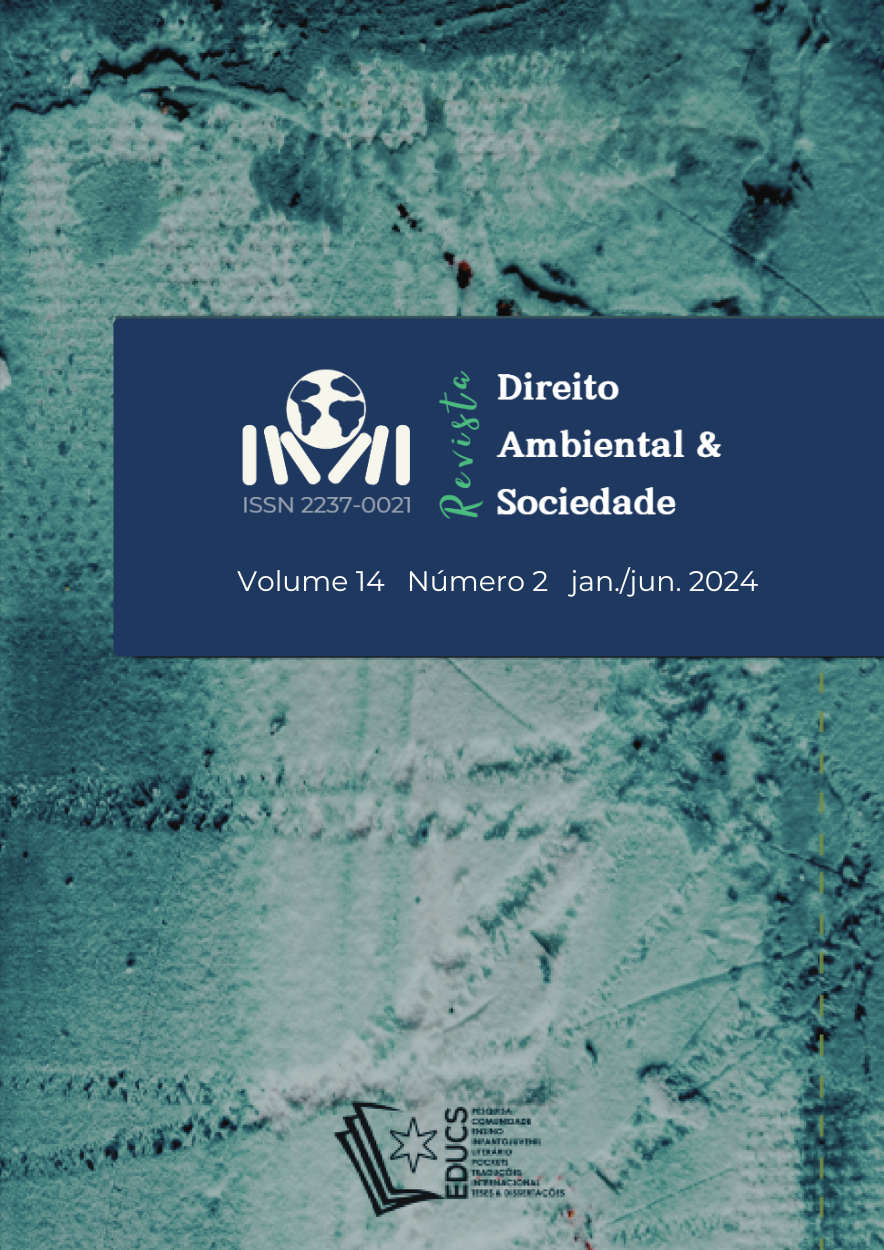Powerless Beings
Solitary Confinement of Humans and Nonhumans in America
DOI:
https://doi.org/10.18226/22370021.v14.n2.19Palavras-chave:
Environmental law, direito dos animais, confinamento animalResumo
Every day, thousands of humans and millions of nonhumans endure solitary confinement. Human prisoners held this way are confined for twenty-two to twenty-four hours a day for weeks, months, or even years on end in cells the size of a parking space. For these humans, the experience is tortuous. Captive animals held in solitary confinement similarly spend much of their lives locked into tiny spaces, isolated, and deprived of the types of interactions and environment essential to their wellbeing. And, like humans, they are driven mad. In human and nonhuman settings, the agony of solitary is chillingly alike and harmful. And, in neither setting is it justifiable or necessary. This Article uses a comparative format to examine the moral, penological and scientific shortcomings of solitary confinement across species. Part I describes how solitary confinement is used in human and nonhuman settings and shows the deep wounds that it inflicts in both. Part II examines why the legal structures under which solitary confinement is imposed (on humans and nonhumans) offer inadequate protections from its depredations. Part III argues that incarcerated beings have no legal protections because they are powerless and invisible. In Part IV, the authors write individually. The author with expertise in prison law (Mushlin) describes how solitary confinement would end in penal facilities if prisoners were empowered and their rights protected. Next, the author with expertise in animal law (Cassuto) explains why solitary confinement for animals in zoos, aquariums and laboratories should and could be abolished. The authors conclude with a call to empower creatures subjected to solitary confinement. If all vulnerable beings are adequately protected, the unnecessary suffering inflicted by solitary confinement will finally end.
Downloads
Referências
Adel Nada & John Somberg, First-in-Man (FIM) Clinical Trials Post-TeGenero: A Review of the Impact of the TeGenero Trial on the Design, Conduct, and Ethics of FIM Trials, 14 A. J. of Therapeutics 594, 595-96 (2007).
Albert Woodfox, Solitary Unbroken: My Four Decades in Solitary Confinement: My Story of Transformation and Hope (2019)
Alexander A. Reinert, Solitary Troubles, 93 Notre Dame L. Rev. 927, 940 (2018)
Alison Shames et al., Solitary Confinement: Common Misconceptions and Emerging Safe Alternatives, VERA Inst. of Just., 4 (2015),
Alka Chandna, Commentary: A Belmont Report for Animals: An Idea Whose Time Has Come, 29 Cambridge Q. Healthcare Ethics 46, 50-51 (2019);
ALLEN BECK, U.S. DEPT. OF. JUST., USE OF RESTRICTIVE HOUSING. IN U.S. PRISONS. AND JAILS, 2011-12, at. 1. (2015).
Amended Class Petition & Complaint, Fields v. Annucci, No. 902997-23 (N.Y. Sup. Ct. Albany Cnty. Apr. 5, 2023);
Motion to dismiss denied and class action certified Brian Lee, NY.Judge Refuses to Toss Inmates' Class-Action Suit Over Solitary Confinement (New York Law Journal. September 13, 2023)
Amy Fettig, 2019 was a Watershed Year in the Movement to Stop Solitary Confinement, ACLU (Dec. 16, 2019).
Angela. Browne et. al., Prisons Within Prisons: The Use of Segregation in the. United States, 24. FED. SENT'C. REP. 46 (2011).
Animal Enterprise Terrorism Act (AETA), 18 U.S.C. § 43 (2006); Ag-Gag Laws, Animal Legal Defense Fund, (last visited Sept. 2, 2023);
Animal Welfare Act, 7.U.S.C. §§ 2131-2160 (2022).
ASCA 2018, supra note 10; Leon Digard et al., Recommendations, Vera Inst. of Just. (May. 2018),
Ashley T. Rubin. & Keramet. Reiter, Continuity in the Face of Penal Innovation: Revisiting the History of Ameri- can Solitary Confinement, 43 LAW & Soc. INQUIRY. 1604, 1608 (2018)
Aspirin for Reducing Your Risk of Heart Attack and Stroke: Know the Facts, FDA, (last updated Dec. 16, 2019).
Behind the Times for. Elephants: So Called "Modern" Zoos.are Harming Elephants with Outdated, Failing, and. Inhuman. Captive Methods, IN. DEFENSE OF ANIMALS (2018).
Bob Comis. What Humane Slaughterhouses Don´t Solve: the last Pig Problem. The DODO. (Mar 10, 2024, 3:24 PM)
Brennan Center for Justice, Criminal Disenfranchisement Law Across the United States, (last updated July 5, 2023).
Brianna Gaskill, Aggression in. Laboratory Mice: Potential. Influences and How to Manage. It, ENRICHMENT. REC. 22, 22-24. (2014).
C. O. Anderson et al., Effects of Handling and Social Isolation upon the Rabbit's Behaviour, 43 Behavior 165, 167 (1972).
C. Teixeira & R. Gomes, _Experimental Models in Vaccine Research: Malaria and Leishmaniasis_, 46 Brazilian J. of Med. & Biological Res. 109, 109 (2013)
Cass R. Sunstein, Standing for Animals._(with Notes on Animal Rights), 47. UCLA L. Rev. 1333, 1335 (2000).
Cass R. Sunstein. & Martha. C. Nussbaum, eds., 2004).
Hope Ferdow- sian. et. al., A Belmont Report for Animals?, 29. CAMBRIDGE Q.. HEALTHCARE ETHICS. 19, 27. (2020),
Cassuto & DlBenedetto, supra note 83, at 47-59; Ferdowsian et al., supra note 83, at 20-22.
Cekanova & Rathore, supra note 292, at 1913
CHARLES DICKENS, AMERICAN. NOTES FOR GENERAL CIRCULATION. 239. (London, Chapman & Hall 1842).
Christopher E. Smith, Courts, Politics, and the Judicial Process 289 (1993)
Christopher Robbins, Cuomo Signs Bill Banning Long Term Solitary Confinement, Gothamist (Apr. 1, 2021),
Chuljung Kwak, Social Isolation Selectively Increases Anxiety in Mice without Affecting Depression-like Behavior, 13 Korean J. of Physiology & Pharmacology 357, 358 (2009).
Cnty. of Albany v. Am.. Soc. for Prevention of Cruelty to Animals, 447.N.Y.S.2d 662.(Sup. Ct. Albany Co. 1982)
Cong. Rsch. Serv., RS22493, the Animal Welfare Act: Background and Selected Animal Welfare Legislation 1 (2016)
Craig Haney & Monia Lynch, Regulating Prisons of the Future: A Psychological Analysis of Supermax and Solitary Confinement, 23 NYU REV. L. & SOC. CHANGE 477, 500. (1997).
Daniela Isabel Bolivar Leon, An Examination of the Growth of Cruelty Free Products Available for the 18-24 Age Range, 12 Business 1, 21 (2020).
David N. Cassuto & Tala DiBenedetto, Suffering Matters: NEPA, Animals, and the Duty to. Disclose, 42. U.. HAW. L... Rev., 41, 51-57 (2020);
David J. Wolfson. & Mariann Sullivan, Foxes in the Hen House: Animals, Agribusiness, and the Law: A Modern American. Fable, in. ANIMAL RIGHTS: CURRENT DEBATES & NEW. DIRECTIONS. 205, 205–33.
Davis v. Ayala, 576. U.S. 257, 288. (2015) (Kennedy, J., concurring).
Delcianna J. Winders, Administrative Law Enforcement, Warnings and Transparency, 79 Ohio State L. J., 451, 474 (2018).
Delcianna J. Winders, Treating Humans. Worse Than Animals?, in CARCERAL LOGICS: HUMAN. INCARCERATION. AND ANIMAL CAPTIVITY. 187, 187–203. (LORI GRUEN & JUSTIN. MARCEAU. EDS., 2022); Karen. M. Morin, Carceral Space: Prisoners and Animals, 48 ANTIPODE 1317. (2016); JUSTIN MARCEAU, BEYOND. CAGES: ANIMAL LAW AND CRIMINAL. PUNISHMENT. (2019).
Dorothy. L. Cheney, Extent and Limits of Cooperation in. Animals, 108 PROCEEDINGS OF THE NATL. ACAD. OF. SCIS. OF THE U.S. 10902 (2011)
Elizabeth Bennion, Banning.the.Bing: Why Extreme Solitary Confinement is Cruel and Far. Too Usual Punishment, 90. IND. L.J. 741, 757-58 (2015);
Craig. Haney, Mental Health Issues. in Long-Term Solitary and "Supermax". Confinement, 49 CRIME & DELINQ. 124, 126 (2003);
Emily Labutta, The Prisoner as One of Us: Norwegian Wisdom for American Penal Practice, 31 EMORY INT’L L. REV. 329, 346 (2017).
Emma K. Adam. et. al., Day-To-Day Dynamics of Experience-Cortisol. Associations in a Population-Based Sample of Older Adults, 103 PROC. NAT'L ACAD. SCI. 17058, 17058 (2006).
Eric Dayton, Could It Be Worth. Thinking about Descartes on Whether Animals Have Beliefs?, 21 Hist. Phil. Q. 63, 64-65 (2004).
Erwin Chemerinsky, The Constitution in Authoritarian Institutions, 32 Supfolk U. L. Rev. 441, 461 (1999)
Eva Maciejewski, The First FDA-Approved Ebola Vaccine: Another Animal Research Victory, Found. for Biomedical Res. (Jan. 9, 2020),
Food Security Act of 1985, Pub. L. No. 99-198, § 1752, 99 Stat. 1354, 1645 (1985)
FWS-Listed U.S. Species by Taxonomic Group - All Animals, U.S. Fish & Wildlife Serv., (last visited Sep. 2, 2023)
Downloads
Publicado
Como Citar
Edição
Seção
Licença
Copyright (c) 2024 Revista Direito Ambiental e Sociedade

Este trabalho está licenciado sob uma licença Creative Commons Attribution 4.0 International License.
Você tem o direito de:
Compartilhar — copiar e redistribuir o material em qualquer suporte ou formato para qualquer fim, mesmo que comercial.
Adaptar — remixar, transformar, e criar a partir do material para qualquer fim, mesmo que comercial.
O licenciante não pode revogar estes direitos desde que você respeite os termos da licença.
De acordo com os termos seguintes:
Atribuição — Você deve dar o crédito apropriado , prover um link para a licença e indicar se mudanças foram feitas . Você deve fazê-lo em qualquer circunstância razoável, mas de nenhuma maneira que sugira que o licenciante apoia você ou o seu uso.
Sem restrições adicionais — Você não pode aplicar termos jurídicos ou medidas de caráter tecnológico que restrinjam legalmente outros de fazerem algo que a licença permita.
Avisos:
Você não tem de cumprir com os termos da licença relativamente a elementos do material que estejam no domínio público ou cuja utilização seja permitida por uma exceção ou limitação que seja aplicável.
Não são dadas quaisquer garantias. A licença pode não lhe dar todas as autorizações necessárias para o uso pretendido. Por exemplo, outros direitos, tais como direitos de imagem, de privacidade ou direitos morais , podem limitar o uso do material.














